You also want an ePaper? Increase the reach of your titles
YUMPU automatically turns print PDFs into web optimized ePapers that Google loves.
SedraStats<br />
49th of the 54 sedras; 6th of 11 in D'varim<br />
Written on 212.8 lines in a Sefer Torah (rank: 21)<br />
44 Parshiyot; 2 open, 42 closed (rank: 1)<br />
110 p'sukim ranks 28th (5th in D'varim)<br />
1582 words ranks 23rd (5th in D'varim)<br />
5856 letters ranks 26th (6th in D'varim)<br />
Slightly larger than average p'sukim; below average for<br />
D'varim. Overall, an averagesized sedra.<br />
But...<br />
Mitzvot<br />
74 of 613 mitzvot 27 positives, 47 prohibitions<br />
Ki Teitzei has the most mitzvot, most positive mitzvot, most<br />
prohibitions, and most parshiyot of any sedra in the Torah.<br />
AliyabyAliya Sedra Summary<br />
Numbers in [square brackets] are the Mitzvacount of Sefer<br />
HaChinuch AND Rambam’s Sefer HaMitzvot. A=ASEI (positive<br />
mitzva); L=LAV (prohibition). X:Y is the perek and pasuk from which<br />
the mitzva comes.<br />
[P> X:Y (Z)] and [S> X:Y (Z)] indicate start of a parsha p’tucha or<br />
s’tuma respectively. X:Y is Perek:Pasuk of the beginning of the<br />
parsha; (Z) is the number of p'sukim in the parsha.<br />
Kohen First Aliya 12 p'sukim 21:1021<br />
[S>21:10 (5)] The "beautiful captive": A Jewish soldier must<br />
resist the "normal" temptations of battle, but is permitted to<br />
take a captive woman only according to the approved Torah<br />
procedures [532,A221 21:11].<br />
Looking at this mitzva from both ends, we first see it as a<br />
"concession to the base inclinations of a man", in the heat of<br />
battle. On the other hand, it demands more of the Jew than is<br />
common of soldiers all over the world, who are notorious for<br />
immoral and atrocious behavior of all sorts.<br />
If he decides after the onemonth waiting period not to marry<br />
her, he must release her without abusing or humiliating her<br />
[533,534; L263,264 21:14].<br />
[S>21:15 (3)] A man may not favor the son of his beloved wife<br />
over his firstborn from a "lessloved" wife. (Implication from<br />
the juxtaposition of these two topics is that marrying for the<br />
wrong motive likely leads to a "hated wife".)<br />
This passage is the source of the firstborn's inheritance.<br />
Ramban counts two mitzvot here the positive command to<br />
give the firstborn a double portion and the prohibition of not<br />
giving it to him. Rambam and the Chinuch include the rules of<br />
the firstborn as part of the laws of inheritance from Parshat<br />
Pinchas and not separately here. This is just one of many<br />
examples of different countings among the Sages who<br />
attempted to identify the traditional 613 mitzvot.<br />
SDT The Vilna Gaon sees a hint to the double portion of<br />
the B'chor in the letters of the word B'CHOR: BETKAF<br />
RESH. Each letter is double the letter before it BET is<br />
double ALEF, KAF is double YUD, REISH is double KUF.<br />
(No other letters are like that.)<br />
[S>21:18 (4)] The "rebellious son" is warned by his parents to<br />
mend his ways. If he continues to defy them, violates certain<br />
mitzvot, engages in a specific sequence of actions, and if he is<br />
of a specific age and at a particular stage of physical<br />
development, and his parents are healthy, normal, and deemed<br />
to be on equal levels of character, then, and only then, would it<br />
be possible to execute him as a "Ben Sorer U'moreh". Although<br />
it is (almost) impossible to reach that ultimate point and<br />
sources indicate that there never actually was a case of "the<br />
rebellious son" this portion of the Torah serves as a stern<br />
warning to wayward children AND their parents! Some mitzvot<br />
seem to be intended primarily as deterrent and Mussar.<br />
Levi Second Aliya 9 p'sukim 21:2222:7<br />
[S>21:22 (2)] Those executed by stoning were hung after death<br />
[535,A230 21:22] for a brief period before sunset. They were<br />
then buried [536,L66 21:23] with the hanging post to avoid<br />
extra embarrassment to the Divine image in which we were all<br />
created.<br />
The hanging of the body after execution (in some cases, not all)<br />
serves as a deterrent for others and is part of the atonement<br />
process for the soul of the guilty party.<br />
Using "Kal VaChomer", we are taught that burial, in general,<br />
and "as soon as is feasible", in particular, is the proper<br />
procedure for the dead [537,A231 21:23].<br />
Note that although the Torah here speaks only of the executed<br />
"felon", the mitzva from the Torah includes burial of all Jewish<br />
dead. This is NOT a Rabbinic deduction, extension, or<br />
legislation it is part of Torah Law the Oral Law.<br />
[S>22:1 (3)] One is required to return identifiable lost objects<br />
to their rightful owners [538,A204 22:1], even if doing so is<br />
difficult. One cannot ignore this responsibility [539,L269 22:3]<br />
even if it is easier to just leave the object alone.<br />
Technically, the laws of LOST & FOUND apply to possessions<br />
Israel Center TT #633 (.pdf version) · page 2 · Shabbat Parshat KI TEITZEI

















